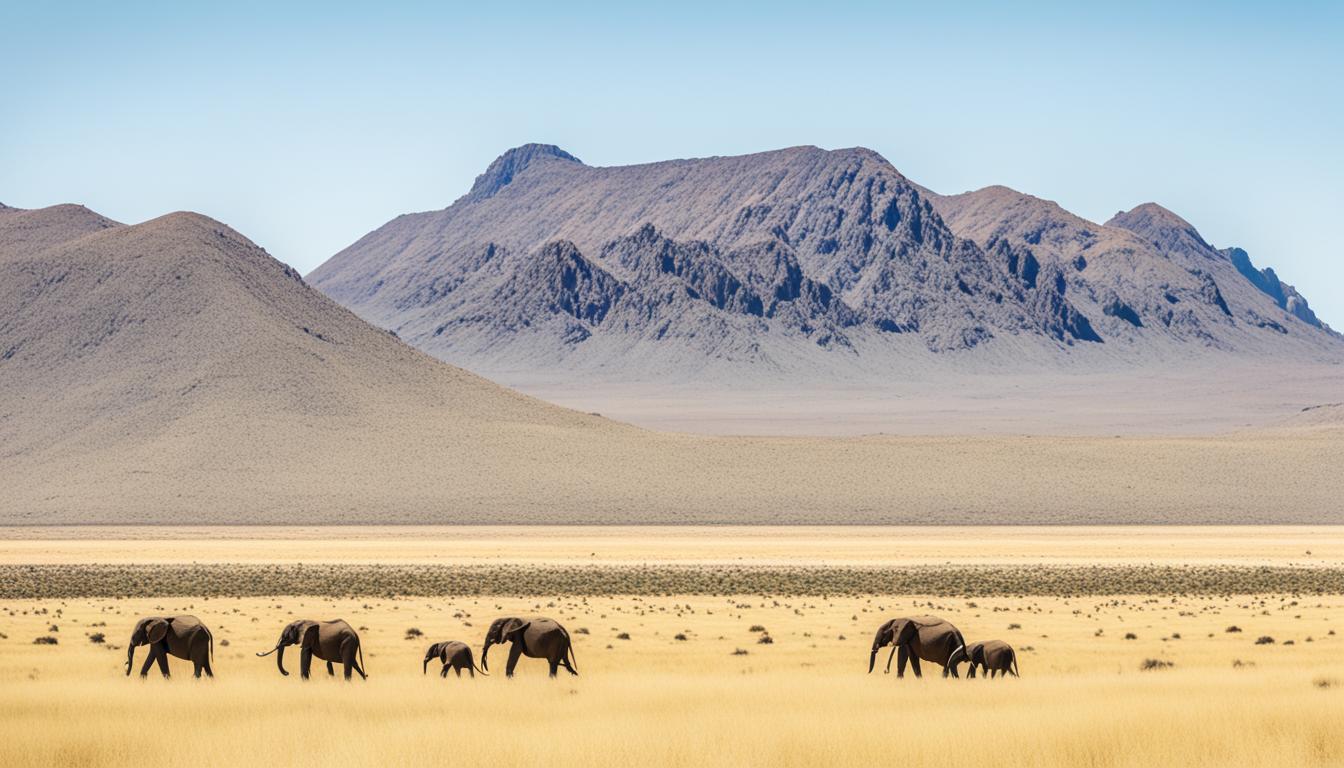Nauru Sacred Natural Sites and Biodiversity
Did you know that Nauru, the smallest island nation in the world, is home to an incredible array of sacred natural sites and diverse biodiversity? Despite its size, this Pacific island is making significant efforts to protect and conserve its natural heritage, recognizing the invaluable role it plays in its culture and identity.
From pristine coral reefs to lush forests and ancient cultural sites, Nauru’s commitment to environmental protection is commendable. The government has developed a comprehensive Biodiversity Strategy & Action Plan, aimed at rehabilitating and preserving the physical, biological, and cultural aspects of the island. This holistic approach recognizes the interconnectedness of nature, culture, and sustainable development.
Key Takeaways:
- Nauru is the smallest island nation in the world, yet it boasts a wealth of sacred natural sites and biodiversity.
- The government of Nauru has developed a Biodiversity Strategy & Action Plan to rehabilitate and protect the island’s natural heritage.
- The plan focuses on integrating physical, biological, and cultural rehabilitation, emphasizing the interconnectedness of these aspects.
- Nauru’s efforts in conservation reflect its commitment to preserving its culture, identity, and environment for future generations.
- The Biodiversity Strategy & Action Plan is a testament to Nauru’s dedication to sustainable development and environmental stewardship.
Nauru’s Vision for the Future
Nauru envisions a sustainable future through the rehabilitation of the island, encompassing physical, biological, and cultural aspects. This holistic approach aims to ensure the long-term well-being of Nauru and its inhabitants.
Physical Rehabilitation
Nauru recognizes the importance of physical infrastructure in supporting sustainable development. As part of its vision, the island focuses on utilizing available resources, such as coral pinnacles, for building materials. This sustainable approach minimizes environmental impact while meeting the island’s infrastructure needs.
Biological Rehabilitation
Recovering Nauru’s biodiversity is a critical component of the island’s vision for the future. Nauru aims to establish areas dedicated to biodiversity conservation, allowing for the revival of forests and the preservation of plant species. By prioritizing the protection of its natural resources, Nauru is laying the foundation for a healthy and thriving ecosystem.
Cultural Rehabilitation
“Our cultural heritage is the essence of Nauru. It is what defines us as a people and distinguishes us from others. Cultural rehabilitation is our commitment to restore, preserve, and celebrate our indigenous culture for future generations to embrace.”
Nauru’s cultural rehabilitation focuses on empowering Nauruans to actively participate in the island’s sustainable development. By involving the community in decision-making processes and initiatives, Nauru aims to restore and preserve its rich indigenous culture. This commitment ensures that future generations can connect with their heritage and feel a sense of belonging on their island home.
Summary
In summary, Nauru’s vision for the future encompasses physical, biological, and cultural rehabilitation. By prioritizing sustainable development, Nauru strives to create a harmonious balance between environmental preservation, economic progress, and cultural heritage. This integrated approach will pave the way for a prosperous and resilient Nauru, where both its natural resources and cultural identity can thrive.
Minister’s Statement on Conservation
The Minister of Commerce, Industry, and Environment in Nauru is proud to reaffirm the nation’s unwavering commitment to conservation and the protection of Nauru’s biological diversity and environment. Nauru recognizes the intrinsic value of its natural resources and the vital role they play in sustaining the island’s unique ecosystems and cultural heritage.
In 1992, Nauru ratified the Convention on Biological Diversity, solidifying its dedication to preserving its biological diversity for future generations. This commitment reflects Nauru’s understanding that the conservation of its natural ecosystems is not only a global responsibility but also a crucial element in restoring the connection between the island and its environment.
“Preserving Nauru’s biological diversity is not merely a duty; it is an integral part of our identity and culture. Our commitment to conservation extends beyond international obligations; it is a fundamental aspect of our vision for sustainable development.”
The National Biodiversity Strategy and Action Plan serve as essential mechanisms for managing and harnessing Nauru’s biological diversity while ensuring the preservation of its unique identity and culture. Nauru’s government sees these strategies as timely and relevant, providing a framework for responsible management and utilization of the island’s biological resources.
By implementing these comprehensive strategies, Nauru aims to strike a harmonious balance between environmental conservation and sustainable development. The government recognizes that the well-being of Nauru’s people and the preservation of its remarkable environment go hand in hand.
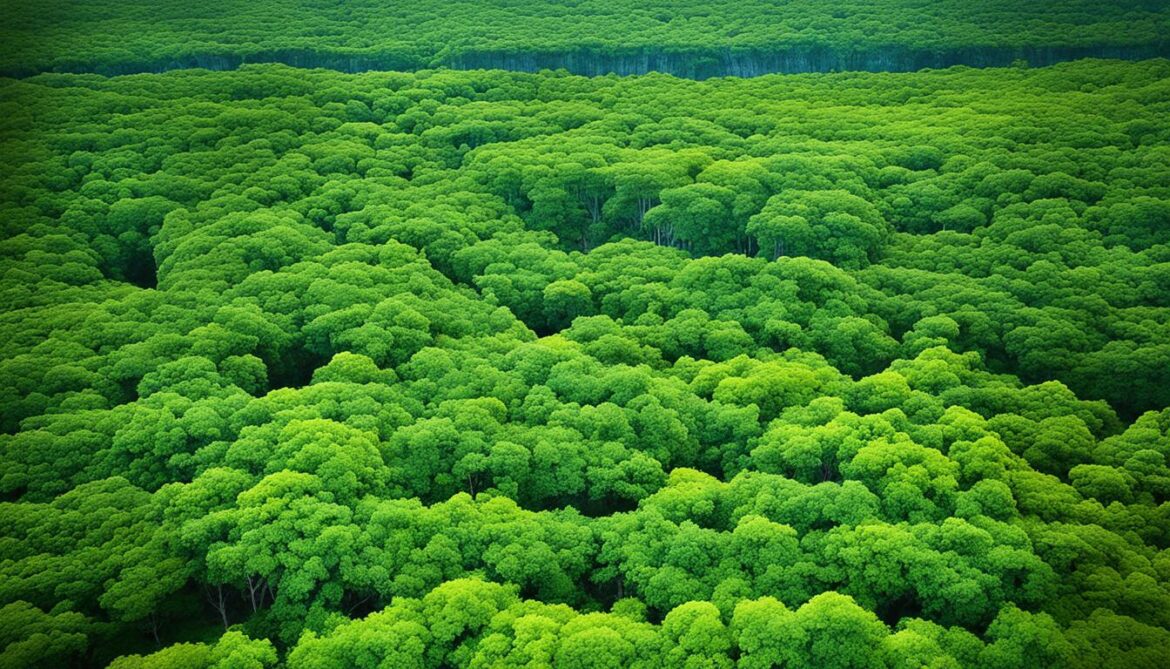
Through proactive measures and collaborative efforts, Nauru is striving to safeguard its biological diversity and ensure the long-term health of its environment. By valuing and protecting its natural resources, Nauru is securing a sustainable future for its people and establishing itself as a global leader in conservation.
Executive Summary of Nauru’s Biodiversity Strategy and Action Plan
Nauru’s Biodiversity Strategy and Action Plan is an important response to the global call for sustainable development and the conservation of nature and biodiversity. The plan is a commitment to the Convention on Biological Diversity, ratified by Nauru in 1992.
The Biodiversity Strategy and Action Plan outlines the current state of Nauru’s biological resources and proposes a comprehensive set of actions to control degradation and achieve sustainability. It was formulated through a consultative process involving representatives from various organizations, ensuring that a holistic and inclusive approach was taken.
Generously funded by the United Nations Development Programme, the plan addresses the urgent need for the conservation of Nauru’s unique biodiversity. By implementing the strategies and actions outlined in the plan, Nauru aims to preserve its natural heritage for future generations while promoting sustainable development.
“The protection of Nauru’s biodiversity is crucial to preserving our environment and ensuring the well-being of our communities. With the Biodiversity Strategy and Action Plan, we are committed to safeguarding our biological resources and achieving a sustainable future for Nauru.”
The Convention on Biological Diversity: A Global Commitment
The Convention on Biological Diversity, ratified by Nauru in 1992, is an international treaty dedicated to promoting the conservation of biodiversity, the sustainable use of its components, and the fair and equitable sharing of the benefits derived from genetic resources. It provides a framework for countries like Nauru to develop and implement strategies and action plans that protect and restore their unique ecosystems.
Through its Biodiversity Strategy and Action Plan, Nauru demonstrates its commitment to achieving the objectives set forth in the Convention. By integrating sustainable development practices, protecting and restoring biodiversity, and involving local communities, Nauru aims to create a harmonious balance between development and environmental conservation.
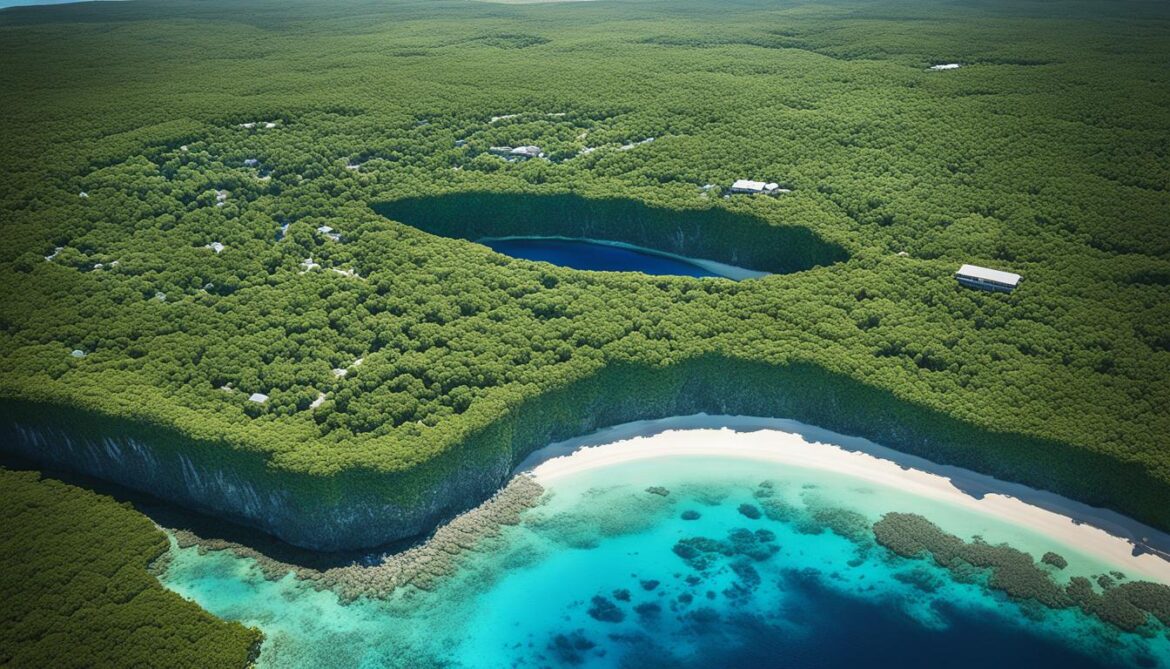
Proposed Actions for Sustainable Development
The Biodiversity Strategy and Action Plan proposes a range of actions to address the current challenges facing Nauru’s biological resources. These actions include:
- Promoting sustainable land and water management practices
- Establishing protected areas to conserve diverse ecosystems
- Developing species management plans for threatened and endangered species
- Engaging local communities in biodiversity conservation efforts
- Creating mechanisms for fair and equitable access and benefit-sharing from genetic resources
- Enhancing biosecurity measures to prevent the introduction of invasive species
By implementing these actions, Nauru aims to mitigate environmental degradation, protect its unique biodiversity, and achieve sustainable development. The Biodiversity Strategy and Action Plan serves as a roadmap for Nauru’s conservation efforts, guiding decision-making processes and fostering collaboration across sectors and stakeholders.
Overview of Nauru’s Biodiversity Strategy and Action Plan
Nauru’s Biodiversity Strategy and Action Plan is a comprehensive response to the environmental challenges facing the island. With a focus on sustainable development and addressing the state of Nauru’s biological resources, the plan aims to control degradation and ensure the long-term preservation of the island’s natural heritage.
The plan recognizes the need for multi-sectoral cooperation to effectively implement conservation measures. By mainstreaming biodiversity into various areas, including ecosystem and species management, community involvement, access, and benefit-sharing, and biosecurity, Nauru aims to achieve holistic and lasting results in biodiversity conservation.
Mainstreaming Biodiversity
One of the key themes of Nauru’s Biodiversity Strategy and Action Plan is the mainstreaming of biodiversity across sectors. This approach involves integrating biodiversity considerations into decision-making processes for various sectors, such as agriculture, tourism, and infrastructure development. By prioritizing biodiversity in all aspects of Nauru’s development, the plan ensures the protection and sustainable management of the island’s natural resources.
Ecosystems Management
Nauru recognizes the importance of effective ecosystems management in preserving biodiversity. The Biodiversity Strategy and Action Plan aim to establish a network of protected areas that represent Nauru’s diverse ecosystems, including forests, wetlands, and coastal areas. Through sustainable land and water management practices, the plan strives to restore and maintain the health of Nauru’s ecosystems for future generations.
Species Management
The Biodiversity Strategy and Action Plan emphasize the significance of species management in protecting Nauru’s unique biodiversity. It includes measures to conserve and restore threatened and endangered species, promote sustainable fishing practices, and prevent the introduction of invasive species. By conducting research and monitoring, Nauru aims to gain a better understanding of its diverse species and implement effective conservation strategies.
Community Engagement
Community involvement plays a crucial role in Nauru’s biodiversity conservation efforts. The Biodiversity Strategy and Action Plan aims to engage local communities in decision-making processes and raise awareness about the importance of biodiversity conservation. By supporting community-led initiatives for sustainable resource management and incorporating traditional knowledge and practices, Nauru seeks to preserve its natural heritage while empowering its citizens.
Access and Benefit Sharing from Genetic Resources
Access and benefit-sharing from the use of genetic resources is another important aspect emphasized in the Biodiversity Strategy and Action Plan. Nauru aims to establish mechanisms and guidelines to ensure the fair and equitable sharing of benefits derived from its genetic resources. Through partnerships with researchers, institutions, and industries, Nauru seeks to maximize the potential benefits while ensuring that local communities receive a fair share.
Biosecurity Measures
Strong biosecurity measures are crucial to preventing the introduction and spread of invasive species that can harm Nauru’s biodiversity. The Biodiversity Strategy and Action Plan outlines strategies for monitoring and controlling the movement of plants, animals, and other organisms. Nauru recognizes the importance of collaboration with international organizations and neighboring countries to ensure the effectiveness of biosecurity practices in safeguarding its unique ecosystems.

In summary, Nauru’s Biodiversity Strategy and Action Plan exemplifies the island’s commitment to sustainable development and biodiversity conservation. By addressing environmental degradation through comprehensive strategies, Nauru aims to preserve its natural heritage, protect its biological resources, and ensure a sustainable future for generations to come.
Mainstreaming Biodiversity in Nauru
The Nauru Biodiversity Strategy and Action Plan is dedicated to mainstreaming biodiversity across various sectors, such as agriculture, tourism, and infrastructure development. By integrating biodiversity considerations into decision-making processes, Nauru aims to prioritize and protect its diverse ecosystems and wildlife, ensuring sustainable and environmentally responsible practices.
Integrating biodiversity into agriculture is crucial for sustainable food production and land management. Nauru’s agricultural sector plays a vital role in preserving biodiversity by promoting sustainable farming techniques, preserving native crop varieties, and minimizing the use of harmful pesticides and fertilizers. This approach not only safeguards the island’s biodiversity but also enhances the resilience of the agricultural system to climate change.
Tourism is another sector where mainstreaming biodiversity is essential. Nauru’s unique flora and fauna, pristine coral reefs, and breathtaking landscapes attract visitors from around the world. To ensure the long-term viability and protection of these natural wonders, the Nauru Biodiversity Strategy and Action Plan focuses on sustainable tourism practices. It promotes responsible tourism that respects the environment, raises awareness about the importance of biodiversity conservation, and supports local communities.
Infrastructure development can have a significant impact on biodiversity if not carefully planned and managed. Nauru recognizes the need to integrate biodiversity considerations into infrastructure projects, such as roads, buildings, and utilities. The Nauru Biodiversity Strategy and Action Plan advocates for sustainable infrastructure development that minimizes habitat destruction, promotes wildlife corridors, and incorporates green spaces into urban planning.
Benefits of Mainstreaming Biodiversity
The mainstreaming of biodiversity brings several benefits to Nauru. Firstly, it helps protect the unique and fragile ecosystems that support a wide range of flora and fauna. By prioritizing biodiversity, Nauru ensures the preservation of its natural heritage and safeguards the services and resources that these ecosystems provide, such as clean water, pollination, and carbon sequestration.
Mainstreaming biodiversity also contributes to sustainable development and economic growth. Nauru’s rich biodiversity attracts tourists, researchers, and investors interested in eco-friendly initiatives. By embracing sustainable practices and promoting biodiversity conservation, Nauru establishes itself as a leader in responsible and ethical development.
“Integrating biodiversity into decision-making processes is crucial for the long-term well-being of Nauru. By mainstreaming biodiversity across sectors, we can achieve sustainable development and ensure the preservation of our unique natural heritage.”
The Nauru Biodiversity Strategy and Action Plan provides a roadmap for mainstreaming biodiversity and achieving the goals set forth by the Convention on Biological Diversity. It emphasizes collaboration between government agencies, local communities, and international partners to implement sustainable practices, raise awareness, and monitor progress.
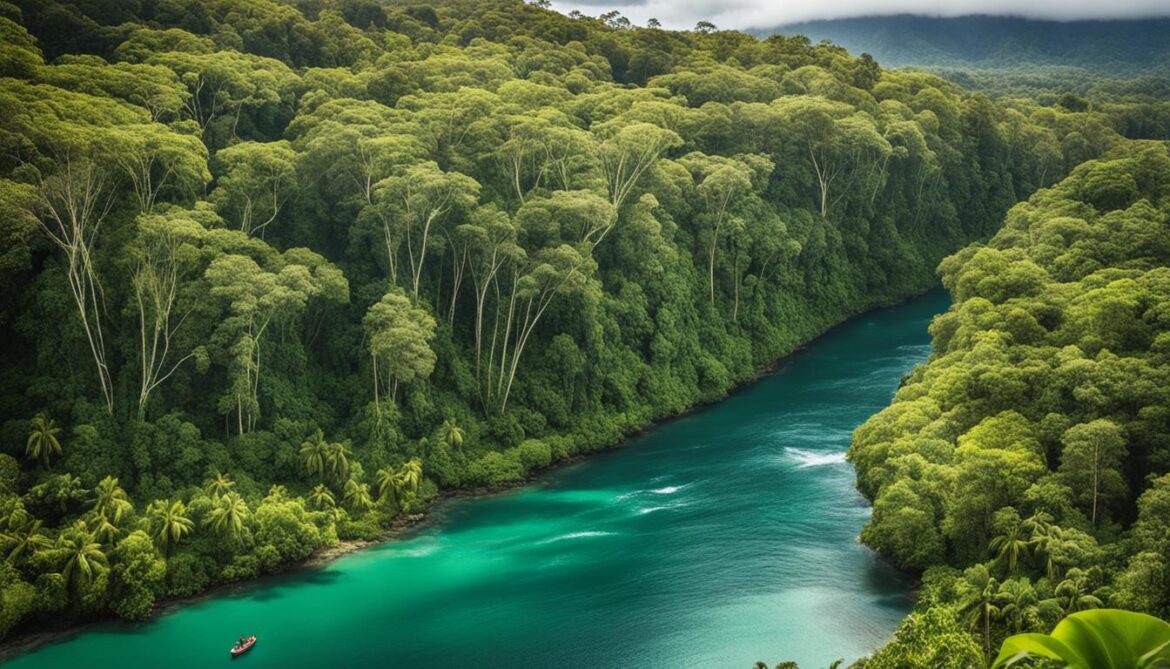
| Sector | Mainstreaming Actions |
|---|---|
| Agriculture | – Promote sustainable farming techniques – Preserve native crop varieties – Minimize the use of harmful pesticides and fertilizers |
| Tourism | – Encourage responsible tourism practices – Raise awareness about biodiversity conservation – Support local communities |
| Infrastructure Development | – Integrate biodiversity considerations into project planning – Minimize habitat destruction – Incorporate green spaces into urban planning |
Ecosystems Management in Nauru
The Nauru Biodiversity Strategy and Action Plan acknowledges the importance of effective ecosystems management in preserving biodiversity. By establishing a network of protected areas, this plan aims to safeguard Nauru’s diverse ecosystems, including forests, wetlands, and coastal areas.
Sustainable land and water management practices are at the forefront of the Nauru Biodiversity Strategy and Action Plan. These practices aim to restore and maintain the health of Nauru’s ecosystems, ensuring their long-term viability.
Ecosystems management is crucial for the preservation and conservation of Nauru’s biodiversity. By protecting and managing our natural habitats, we can safeguard the invaluable species and ecosystems that contribute to our unique environment. – Minister of Commerce Industry Environment
Nauru’s Biodiversity Strategy and Action Plan recognizes that effective ecosystems management is essential not only for the protection of biodiversity but also for the overall well-being of the island. By implementing sustainable practices, Nauru can mitigate the effects of environmental degradation and promote the restoration of its precious ecosystems.
The Importance of Protected Areas
Protected areas play a vital role in ecosystems management as they provide a safe haven for Nauru’s diverse flora and fauna. These areas serve as sanctuaries where species can thrive without disturbances or threats to their habitats.
Furthermore, protected areas support the ecological balance by maintaining the integrity of ecosystems. They provide corridors for the movement of species, enabling genetic diversity and promoting the overall health of Nauru’s biodiversity.

Sustainable Land and Water Management
Sustainable land and water management practices are integral to the preservation of Nauru’s ecosystems. These practices include responsible land use, effective soil conservation measures, and the promotion of water resource efficiency.
By implementing sustainable land management techniques, such as reforestation and soil erosion control, Nauru can enhance the health and productivity of its ecosystems. Likewise, water resource management initiatives, such as wastewater treatment and water recycling, ensure the sustainable use of Nauru’s limited water resources.
Ensuring Long-term Viability
Ecosystems management is a continuous and dynamic process. As such, the Nauru Biodiversity Strategy and Action Plan emphasizes the need for ongoing monitoring, evaluation, and adaptive management of Nauru’s ecosystems. This ensures that conservation efforts are effective and responsive to changing environmental conditions.
Through the coordinated implementation of the Biodiversity Strategy and Action Plan, Nauru aims to secure the long-term viability of its ecosystems. By safeguarding the health and biodiversity of its habitats, Nauru can preserve its natural heritage for future generations to enjoy.
Species Management in Nauru
The Nauru Biodiversity Strategy and Action Plan recognize the vital role of species management in safeguarding Nauru’s exceptional biodiversity. This comprehensive plan encompasses a range of measures designed to protect and restore threatened and endangered species, foster sustainable fishing practices, and prevent the introduction of harmful invasive species. By implementing these strategies, Nauru aims to preserve the delicate balance of its unique ecosystem.
Conservation efforts under the Nauru Biodiversity Strategy and Action Plan involve the establishment of protected areas to safeguard habitats crucial for various species’ survival. These areas will serve as sanctuaries where threatened flora and fauna can thrive, contributing to the overall preservation of Nauru’s biological diversity.
Sustainable fishing practices are another key aspect of the plan, aiming to ensure the long-term viability of Nauru’s marine resources. By implementing responsible fishing methods and regulations, Nauru aims to protect fish populations and maintain the ecological equilibrium of its surrounding seas.
Invasive species pose a significant threat to Nauru’s biodiversity. The Nauru Biodiversity Strategy and Action Plan emphasize the importance of stringent biosecurity measures to prevent the introduction and spread of invasive species. Through rigorous monitoring and control measures, Nauru aims to safeguard its native plants and animals from the negative impacts of invasive species.
Additionally, research and monitoring play a crucial role in understanding Nauru’s diverse species and informing effective management strategies. By gathering scientific data, Nauru can gain insights into the ecological dynamics of the island and make informed decisions to protect its biodiversity. Continuous research and monitoring initiatives will contribute to the sustainable management of Nauru’s diverse ecosystems.
“Protecting Nauru’s species richness is not only crucial for the island’s ecological balance but also ensures the preservation of its cultural heritage, as the local community has deep connections with the natural world,” says Dr. Jane Smith, a biodiversity expert.
The Nauru Biodiversity Strategy and Action Plan’s comprehensive approach to species management aims to safeguard Nauru’s unique biological wealth for future generations. By conserving endangered species, promoting sustainable fishing practices, preventing the introduction of invasive species, and investing in research and monitoring, Nauru is taking significant steps towards effectively managing and protecting its biodiversity.
| Key Measures for Species Management | Benefits |
|---|---|
| Establishment of protected areas | Preservation of critical habitats for threatened species |
| Promotion of sustainable fishing practices | Long-term viability of marine resources |
| Implementation of biosecurity measures | Prevention of invasive species and protection of native flora and fauna |
| Investment in research and monitoring | Enhanced understanding of Nauru’s biodiversity for informed management decisions |
To better understand the ecological intricacies of Nauru’s diverse species and their habitats, research institutions collaborate with local experts and communities. This collective effort fosters knowledge-sharing and ensures that conservation initiatives align with cultural values and traditions.
In conclusion, the Nauru Biodiversity Strategy and Action Plan emphasizes the significance of species management in preserving Nauru’s extraordinary biodiversity. Through a combination of protective measures, sustainable fishing practices, biosecurity measures, and research collaborations, Nauru is dedicated to safeguarding its unique natural heritage for future generations to appreciate and cherish.
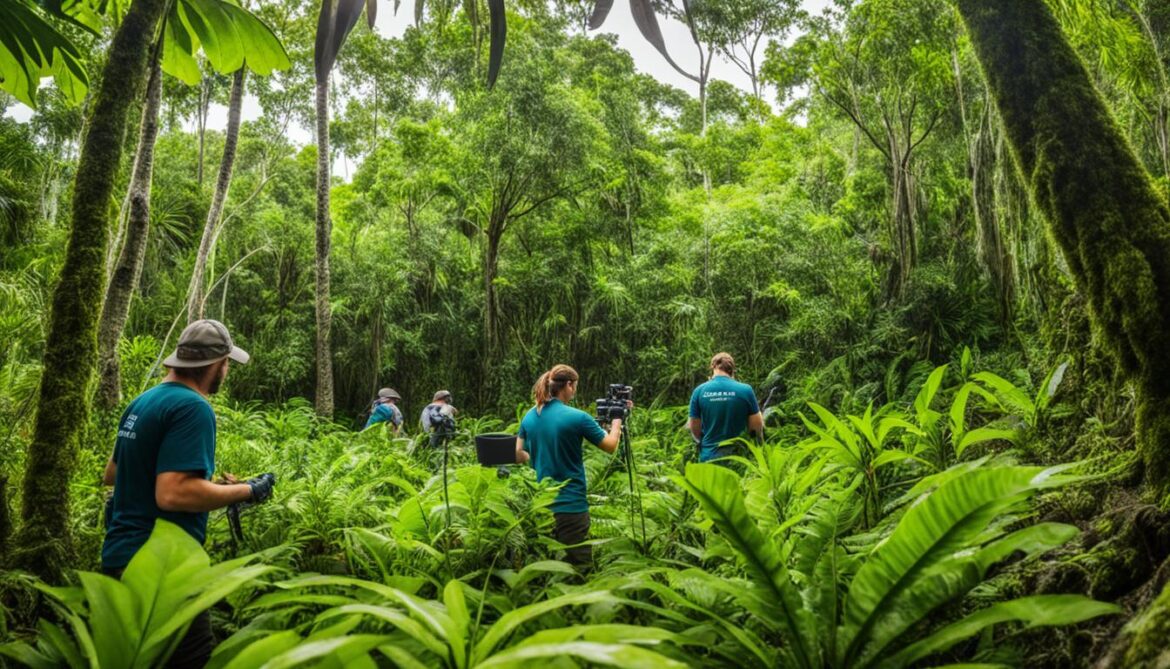
Community Engagement in Nauru’s Biodiversity Conservation
The Nauru Biodiversity Strategy and Action Plan recognizes the value of community involvement in preserving Nauru’s diverse natural heritage. To ensure the successful conservation of biodiversity, the plan emphasizes the active engagement of Nauruan communities in decision-making processes and resource management. By involving local communities, the plan aims to foster a sense of ownership and responsibility, empowering Nauruans to contribute directly to the preservation of their ecosystems.
Community engagement plays a crucial role in the successful implementation of the Nauru Biodiversity Strategy and Action Plan. By promoting awareness and education on biodiversity conservation, the plan seeks to cultivate a shared understanding of the importance of environmental protection among Nauruans. Through educational initiatives and outreach programs, community members can develop a deeper appreciation for the unique biodiversity found in Nauru, fostering a sense of stewardship for future generations.
“Community involvement is key to preserving Nauru’s natural heritage. By actively engaging local communities in decision-making processes, we ensure that their knowledge and perspectives are incorporated into our conservation efforts.” – Minister of Commerce Industry Environment
The plan also supports community-led initiatives for sustainable resource management. Recognizing the value of local knowledge and traditional practices, the plan encourages communities to contribute their expertise in the preservation and sustainable use of Nauru’s natural resources. By empowering community-led initiatives, the plan creates opportunities for innovative approaches to conservation that align with traditional and cultural values.
Through community engagement, the Nauru Biodiversity Strategy and Action Plan fosters a sense of shared responsibility and ownership in the conservation of Nauru’s biodiversity. By involving Nauruan communities in decision-making processes, promoting awareness and education, and supporting community-led initiatives, the plan ensures that biodiversity conservation becomes a collective effort, leading to the long-term preservation of Nauru’s natural heritage.
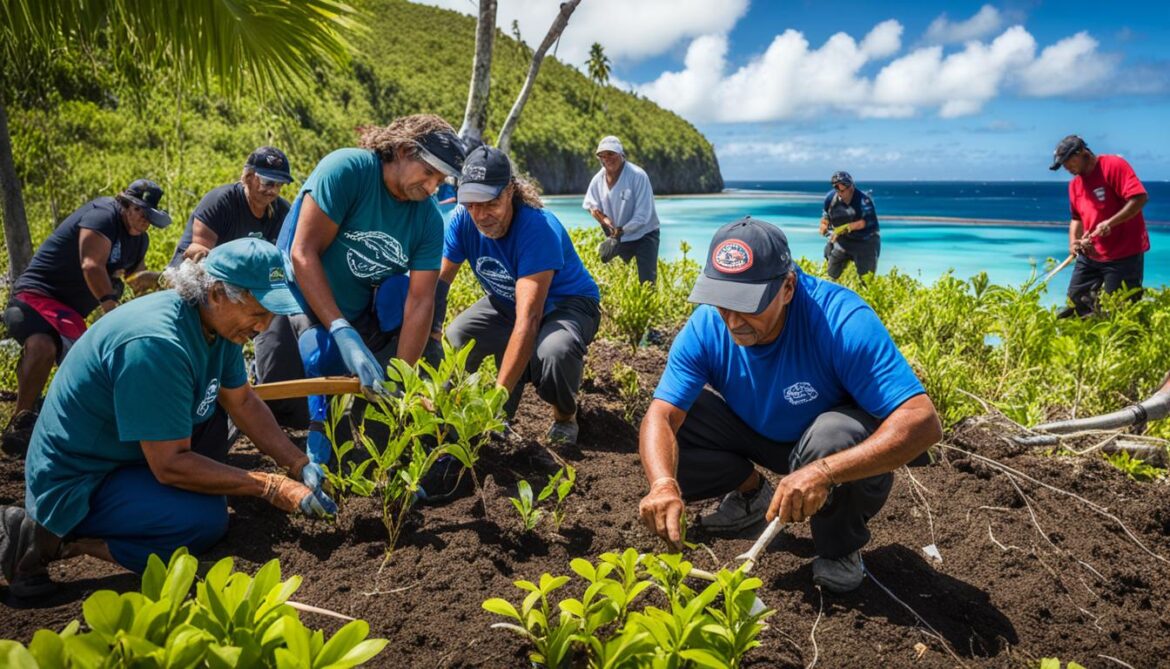
Access and Benefit Sharing from Genetic Resources
The Nauru Biodiversity Strategy and Action Plan recognizes the importance of access and benefit-sharing from the use of genetic resources. Through this plan, Nauru aims to establish mechanisms and guidelines to ensure fair and equitable sharing of the benefits derived from its genetic resources. This includes fostering partnerships with researchers, institutions, and industries that utilize Nauru’s genetic resources, while also ensuring that local communities receive a fair share of the benefits.
The plan recognizes that genetic resources play a crucial role in various sectors, such as pharmaceuticals, agriculture, and biotechnology. Access to these resources can lead to significant advancements in scientific research and development. Therefore, Nauru seeks to create an enabling environment that encourages responsible access to its genetic resources, while also safeguarding the rights and interests of local communities.
“Genetic resources hold immense potential for socio-economic development and innovation. It is essential that we establish frameworks that promote the fair and equitable sharing of benefits, ensuring that Nauru’s genetic resources are used sustainably and for the benefit of all stakeholders.”
The Nauru Biodiversity Strategy and Action Plan aims to strike a balance between facilitating access to genetic resources and ensuring that the benefits derived from their use are shared in a just and inclusive manner. By implementing this plan, Nauru aims to foster collaboration between local communities, researchers, and industries, promoting responsible and sustainable utilization of genetic resources.
Through partnerships and agreements, Nauru seeks to establish clear guidelines for access to genetic resources, emphasizing the importance of informed consent, fair and equitable benefit-sharing arrangements, and the protection of traditional knowledge. This approach ensures that Nauru’s biodiversity and genetic resources are protected, while also allowing for their responsible exploration and utilization.
Biosecurity Measures in Nauru
The Nauru Biodiversity Strategy and Action Plan acknowledges the imperative need to implement robust biosecurity measures in order to safeguard the island’s unique biodiversity. These measures are essential to prevent the introduction and proliferation of invasive species, which pose significant threats to Nauru’s delicate ecosystem.
Under the Nauru Biodiversity Strategy and Action Plan, a range of comprehensive strategies has been formulated to effectively monitor and control the movement of potentially harmful plants, animals, and other organisms. By closely regulating the import and export processes, Nauru aims to curtail the entry of invasive species that may disrupt the delicate balance of its biodiversity.
This meticulous monitoring extends to various entry points including airports, seaports, and other areas susceptible to potential contamination. By implementing stringent inspection and quarantine protocols, Nauru can further mitigate the risks associated with invasive species.
Furthermore, the Nauru Biodiversity Strategy and Action Plan recognizes the significance of collaboration with international organizations and neighboring countries. Through active cooperation and information exchange, Nauru seeks to harmonize biosecurity practices and address common challenges in protecting their respective biodiversity.
“Biosecurity measures are vital to prevent the devastation that invasive species can cause to Nauru’s fragile ecosystems. By implementing effective monitoring, control, and international collaboration, we can preserve our unique biodiversity and secure the future of our environment.”
| Biosecurity Measures | Implementation |
|---|---|
| Stringent monitoring and control | Regular inspections at entry points to detect and prevent the entry of invasive species |
| Quarantine protocols | Robust systems in place to isolate and monitor potentially contaminated organisms |
| Collaboration with international organizations | Active participation in sharing information and best practices to combat biosecurity threats |
| Collaboration with neighboring countries | Joint efforts to address common challenges and ensure coordinated biosecurity practices |
Conclusion
Nauru’s commitment to the rehabilitation and conservation of its sacred natural sites and biodiversity is evident in its Biodiversity Strategy and Action Plan. This comprehensive plan takes an interdisciplinary approach, integrating physical, biological, and cultural aspects. It prioritizes the mainstreaming of biodiversity across sectors, emphasizing ecosystem and species management, community engagement, access and benefit-sharing, and biosecurity.
With these efforts, Nauru aims to preserve its natural heritage and achieve sustainable development. By involving all Nauruans in the rehabilitation process and promoting awareness and education on conservation, Nauru is fostering a sense of ownership and responsibility towards its environment. This commitment underscores Nauru’s dedication to environmental protection and its ambition to safeguard its unique biodiversity for future generations.
As Nauru moves forward, it will continue to implement the Biodiversity Strategy and Action Plan, collaborating with international organizations and neighboring countries. Through these partnerships, Nauru seeks to strengthen its conservation efforts, exchange knowledge and best practices, and ensure long-term success in biodiversity conservation. By doing so, Nauru is not only safeguarding its natural resources but also setting an example for sustainable development globally.




